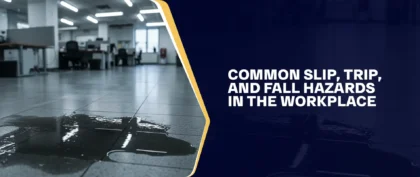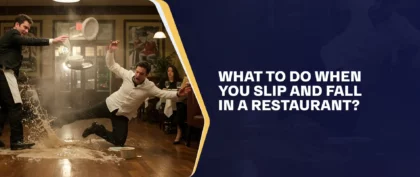Table of Contents
Slips and falls might seem harmless, often resulting in nothing more than a bruised ego and a moment of embarrassment. However, these accidents can also result in injuries that have significant physical and financial consequences.
While minor incidents cause scrapes or bruises, major slip and fall accidents can lead to fractures, head trauma, and other potentially life-altering injuries. However, even a seemingly insignificant fall can disrupt daily routines and unexpectedly impact quality of life.
Imagine this: You’re walking out of a grocery store when you slip on a spilled drink near the exit. At first, it seems like a minor fall, just a few bruises on your arm and scrapes on your wrist. However, the next morning, you wake up to searing pain in your wrist. After a trip to the doctor and an X-ray, it’s confirmed that your wrist is broken. You’ll have to wear a cast for several weeks, and you can’t go to work because of your injury. What seemed like a small accident has suddenly turned into unexpected medical bills and lost wages.
Knowing the possible effects of falls can help those affected to take the right steps towards recovery.
What You Need To Know About Common Injuries After A Fall
Slip-and-fall accidents can happen to anyone, regardless of age or overall health. According to the National Safety Council, more than 8.5 million people received emergency medical care for fall-related injuries in 2022. Accidents like these often cause injuries that need medical attention. Delayed treatment can lead to serious complications, so it’s wise to see a doctor, even if the incident seems minor.
Below are some of the most common fall-related injuries:
Soft Tissue Damage
Soft tissue injuries, like sprains, strains, and bruises, affect muscles, tendons, ligaments, and skin. These injuries can impact your daily activities and well-being. While they may not seem as serious as a severe brain injury, they can still disrupt your life and should be taken seriously. These bodily injuries can result in significant pain, swelling, and reduced mobility, sometimes lasting weeks or even months. Symptoms often include localized discomfort, soreness, skin discoloration, and difficulty moving the affected area.
The knee is especially vulnerable during falls. Landing directly on your knee or twisting it at an awkward angle can damage ligaments, tendons, or cartilage. This can cause swelling, pain, and difficulty bending or bearing weight. A popping or clicking sound at the time of injury might indicate a ligament tear. The knee has two C-shaped pieces of cartilage called menisci. Damage to these is known as a meniscus tear, a common knee injury. These injuries may require medical intervention and physical rehabilitation to heal properly.
Lacerations & Cuts
Falling on gravel, rubble, or sharp objects can cause cuts and scratches. Dirt and debris might get into the wound, leading to infections if not properly cleaned. Most minor cuts heal on their own, but deeper ones may need stitches. In some cases, these injuries can be painful and may lead to permanent scars.
Any cut, puncture, or tear can lead to complications if not treated properly. Bacteria can enter the bloodstream through open wounds and cause infection. Watch for signs of infection like redness, swelling, or pus, and seek medical care if these symptoms appear.
Nerve Damage
Nerves are spread throughout your entire body. When you fall, your nerves can sustain damage in multiple ways, such as the following:
- In a fall, sudden and violent movements can stretch and tear nerves, especially in the arms, shoulders, and neck. This occurs because the impact and unnatural posture can twist or bend the body. Delicate nerves can become overstretched or pinched, leading to severe pain, numbness, tingling, and weakness in affected areas.
- Broken bones from a fall can directly damage nearby nerves when they press against or tear nerve structures. This causes pain, numbness, and weakness. Swelling and inflammation during healing can worsen these issues, potentially leading to chronic pain or neuropathy. Effective treatment requires understanding bone fractures and nerve injuries, which may include physical therapy, pain management, or surgery.
- Swelling from a soft tissue injury can press on nerves, causing pain, numbness, and tingling. This pressure can disrupt nerve function, leading to discomfort and potentially more serious complications if not treated.
A nerve injury causes various symptoms, such as:
- Numbness or tingling in the limbs.
- A burning or “pins and needles” sensation.
- Muscle weakness or atrophy.
- Muscle twitching.
- Pain or sensitivity to touch.
Fractures
Fractures are among the most common injuries caused by falling, affecting approximately 20-30% of individuals who fall. Even a same-level fall or a fall from a low height can result in a broken bone, especially if the impact is concentrated on a weakened or vulnerable bone. The most commonly affected areas include:
- Hips — Many falls cause individuals to land directly on their hips, increasing the risk of a fracture in this area.
- Wrists — People instinctively try to catch themselves by extending their hands to break a fall, potentially resulting in a fractured wrist.
- Ankles — A fall that causes the foot to twist, roll, or land awkwardly can result in a broken ankle.
Older adults are particularly vulnerable to fractures after a fall. As people age, their bones become weaker and more fragile, making them less stable and more prone to serious injuries. Hip fractures are prevalent among those aged 65 years and older, with over 250,000 cases reported each year in the United States.
Traumatic Brain Injuries
A traumatic brain injury (TBI) can occur when a person falls and strikes their head directly on the ground or another object, like a table or a countertop. In some cases, a TBI can develop even without direct contact if the head is jolted forcefully enough during the fall to cause brain damage. Symptoms can include:
- Headaches
- Dizziness
- Disorientation
- Loss of consciousness
- Nausea
- Vomiting
A brain injury accident can lead to specific injuries with symptoms that may not appear right away, and you might not realize the severity of your condition until it worsens. Ensure you seek medical care after a significant fall, especially if you hit your head or experience the symptoms above.
Spinal Cord Injuries
Falls that cause someone to land on their back can seriously damage the spinal cord. Even on flat surfaces, falls can lead to slipped or compressed discs and nerve injuries, impacting mobility and comfort. If the back hits an elevated surface, like a curb or object, the trauma can be even more severe.
Spinal cord injuries from falls are very serious and can lead to long-term or permanent damage, like paralysis. They can also affect bladder and bowel control. Warning signs include weakness, numbness, loss of control in any part of the body, and severe neck, head, or back pain. If you have any of these symptoms after a fall, seek medical attention immediately to reduce long-term damage and prevent further complications.
Potential Long-Term Health Consequences Of Fall Injuries
The impact of a fall injury can be different for everyone. How your body heals depends on your overall health, the injury’s severity, and the accident’s circumstances. While some injuries may heal completely, others can lead to lasting effects, such as:
- Chronic Pain — Chronic pain from fractures, sprains, and TBIs can last for months or years, significantly impacting daily life. It can affect your ability to work, enjoy hobbies, and perform simple tasks like walking or sleeping comfortably.
- Reduced Mobility & Independence — Depending on the nature and severity of the injury, you might have difficulty walking, climbing stairs, or performing everyday activities in the long term. Nearly 50% of seniors aged 65 and older who experience hip fractures face challenges that can significantly impact their ability to live independently after the injury.
- Psychological Impact — A traumatic fall accident can lead to post-fall syndrome, where people are afraid of falling again. Those affected may question their independence and deliberately restrict their movements to reduce the risk of falling.
- Disability — Severe injuries like spinal cord damage or TBIs can lead to permanent disability, significantly altering a person’s lifestyle. This affects their ability to participate in social activities or care for themselves independently. The loss of income and additional costs of specialized care can also impact family members.
Sadly, falls can also lead to fatalities, especially among older adults. According to the NFSI, falls are the second leading cause of injury-related deaths for those aged 65 to 84 and the leading cause for those aged 85 and up. However, falls can also be fatal for healthy adults, causing severe injuries like head trauma or internal bleeding.
Treatment Options For Fall Injuries
The treatment for a fall injury varies depending on the type and severity of the injury. Some examples are:
- Rest, Ice, Compression, and Elevation (RICE) — This is a method that helps reduce swelling and alleviate pain for minor injuries like sprains and strains. Rest allows the injured area to heal while applying ice, which helps reduce inflammation and numb the pain. Compression and elevation further minimize swelling and support the healing process.
- Immobilization — Injuries like fractures and sprained wrists may require a brace, splint, or cast to prevent the affected area from moving, reducing the chances of further damage.
- Rehabilitation Programs — Physical therapy, chiropractic care, and other rehabilitation programs can help restore mobility, strength, and flexibility. These treatments can also help with pain and reduce the risk of future injuries.
- Medication — Over-the-counter drugs and prescriptions may be used to manage pain and inflammation.
- Surgery — In severe cases, surgical intervention may be necessary to repair the damage. This is particularly common among older adults who may require hip replacements after falling.
Proper and timely treatment is crucial to ensure optimal recovery and prevent complications. However, accessing the necessary treatment and care can be challenging for many patients.
Most Common Types Of Falls
The kind and severity of a fall-related injury might vary depending on how one falls.
- Same-Level Fall — Falls at the same level can occur on relatively flat surfaces, ramps, and stairs. Although they may seem less dangerous, they can still lead to serious injuries or fatalities. In 2022, 144 workers were killed due to injuries from a same-level fall. It has different types:
- Slip and Fall — Slip-and-fall accidents cover a range of scenarios where a person might lose their balance and fall due to a variety of hazards:
- Slippery Surfaces — A person might slip and fall when they lose their balance due to a slick surface. For example, they might slip on a spilled drink in a restaurant, a patch of ice, or a freshly mopped surface. This type of accident is often linked to neck, head, or back injuries, especially if the individual falls backward with no way to brace for impact.
- Obstructions — An obstruction on someone’s path can cause them to trip and fall, often making them fall forward. If a person braces for the fall by extending their arms, they are highly likely to sustain injuries in the fingers, hands, wrists, arms, or shoulders. However, if they can’t brace themselves, they might sustain facial or head injuries, which can be severe.
- Dead Fall — Occurs when someone collapses without slipping or tripping, often due to dizziness, leg weakness, medication side effects, or intoxication. This type of fall can happen suddenly and may result in serious injuries.
- Slip and Fall — Slip-and-fall accidents cover a range of scenarios where a person might lose their balance and fall due to a variety of hazards:
- Fall From Height — This refers to falling from an elevated position like a ladder, scaffolding, roof, or building. Such falls often result in serious injuries and fatalities. Construction workers are particularly at risk, with a fall-related fatality rate seven times higher than that of workers in other industries.
Areas Where Fall-Related Injuries Happen The Most
A slip-and-fall accident can happen anywhere and anytime due to various hazards. Parking lots, for example, are known not only for car accidents but also for slips and falls. Wet or slippery surfaces from spills, rain, or ice, as well as cracks in the pavement, uneven or damaged flooring, and cluttered walkways, can all cause slips and falls. Poor lighting, inadequate maintenance, and broken structures also contribute to falling incidents.
These hazards are present in various locations, including but not limited to:
- Apartment Buildings
- Construction Sites
- Office Buildings
- Shopping Malls
- Grocery Stores
- Restaurants
- Sidewalks
- Stairwells
- Swimming Pools
- Nursing Homes
Property owners or managers are responsible for ensuring safety, whether it’s a construction site with elevated hazards, a grocery store with risks of spilled liquids, or an office with heavy foot traffic in hallways. They must address their premises’ unique and specific dangers to maintain safe conditions for visitors.
The Hidden Costs Of Falls
The financial consequences of a fall-related injury can be overwhelming, often extending far beyond the immediate treatment costs. Long-term medical expenses like rehabilitation and medication can accumulate quickly, especially for catastrophic injuries. In cases of permanent disability, patients may need to invest in specialized equipment like wheelchairs or modify their homes to accommodate mobility challenges.
These unexpected costs can significantly burden the average American family. A nasty fall can drain one’s savings and cause financial instability. Even if the victim has insurance, it might not cover all the resulting losses from the fall accident.
Furthermore, the loss of income during recovery can aggravate financial stress. For example, someone recovering from a fracture might be unable to work for weeks or months, leading to missed paychecks that could have gone toward their rent or groceries. In 2022 alone, hundreds of thousands of workers were injured severely enough to take a leave from work.
For those who suffer permanent injuries, the long-term effects can be even more profound. For instance, a victim sustains paralysis or a TBI with irreversible cognitive impairment. They may be unable to return to their previous line of work or any job. This loss of earning potential compounds the financial strain, making it critical for victims to understand their rights and seek compensation to cover immediate and future costs.
What To Do If You’re Injured After A Fall
If you experience a fall, it’s crucial to prioritize your safety and avoid making any injury worse. Follow these steps to protect your health:
- Avoid forcing any movement. If you feel sharp pain or cannot move, don’t stand up. Instead, assess your condition before attempting to move. Moving too soon or incorrectly after a fall can worsen your injuries. If you’re able to get up, do so slowly and cautiously.
- Seek help from someone nearby if you’re in a public place or at home with other people. Have them call 911 for you if necessary.
- If you’re on a commercial property, report the accident to the person in charge. For instance, if you slipped and fell at Home Depot, ask for the store manager. If the incident happened at work, report it to your supervisor.
- Unless you need to go to the hospital right away, stay at the scene and take some photos and videos of where you fell. Capture what might have caused the accident, like a broken handrail or a wet floor. If you have any visible injuries, make sure to document those as well.
- Collect information from any eyewitnesses. If you’re on commercial property, note the name of the manager on duty or anyone overseeing the place.
- Seek medical attention as soon as possible. Some injuries might not be immediately apparent but can worsen over time. Early medical intervention can help identify hidden issues and prevent complications.
Legal Consequences Of Fall Injuries On Another’s Property
A fall isn’t always just due to clumsiness or a random loss of balance. Sometimes, it’s because of someone else’s negligence. Property owners have a legal duty to maintain safe conditions for visitors, tenants, or customers. This includes property managers, landlords, store owners, homeowners, construction companies, and others in charge of premises.
If they fail to keep the property safe or ignore hazards, they may be responsible for your injuries. You might be able to file a premises liability claim to seek compensation for your losses, including medical expenses, lost wages, and pain and suffering.
If you’re injured, consulting a premises liability attorney promptly can be beneficial. They can determine if you have a valid case and guide you through the legal process. At Arash Law, we’ll evaluate your case for free. Our injury lawyers will explain your legal options and your rights and help you make an informed choice for your recovery.
Frequently Asked Questions
How Much Compensation Can I Receive For A Fall Injury?
The money you may be able to pursue for a fall injury depends on the severity of your injuries and the extent of your losses. In general, serious injuries result in higher settlements or awards because they account for significant medical expenses, extended recovery periods, and more incredible physical and emotional pain. However, even seemingly minor cases can lead to high compensation amounts, depending on the situation.
To better understand the potential value of your slip-and-fall case, consult with a qualified attorney for slip-and-fall accidents. They can thoroughly evaluate your case and consider future treatment costs, reduced earning potential, and all other current and long-term impacts to estimate a fair value. Your injury lawyer will also advocate for appropriate compensation during negotiation and litigation.
How Long After A Fall Injury Can You File A Claim?
The deadline for filing a slip and fall claim depends on the case. For a personal injury involving the government, victims have six months to file a notice of claim with the respective agency. Workers’ compensation claims have a one-year deadline from the date of injury.
For a personal injury lawsuit, the victim generally has two years from the accident date or when they discovered their injury. Once the statute of limitations expires, you may no longer bring a case to court, regardless of your evidence or injury severity.
Consult a slip and fall accident lawyer as soon as possible to help protect your rights and identify critical deadlines. They can help you understand the legal process, navigate the system, and clarify your claim’s validity.
Do I Need A Personal Injury Lawyer For A Slip And Fall?
Slip-and-fall lawyers offer valuable assistance in navigating the complexities of an insurance claim or lawsuit. Here’s how they can help:
- Establish Liability — A lawyer for slip-and-fall accidents can thoroughly investigate your case to identify who may be liable for your injuries. For example, if you had a slip-and-fall accident at Walmart due to a slippery floor without a warning sign, your attorney can argue that the store failed to maintain a safe environment for its patrons. By proving negligence, you can pursue compensation for your injuries and losses.
- Advocate for You — If you get a slip-and-fall lawyer, you gain an ally who is committed to representing your interests throughout the claims process, from filing to negotiations to trial. If insurance companies offer low settlements, they can negotiate on your behalf. At Arash Law, we stand firm to help protect our clients’ rights, even when we face powerful defendants like Costco, Target, and other large corporations in your slip-and-fall case.
Your Fall May Not Be Your Fault! Contact Our Slip-And-Fall Attorneys
Slip-and-fall accidents are far more common than most people realize, and the harm they cause often extends beyond physical injuries. They can disrupt your daily life, impact your ability to work, and lead to significant financial strain, leaving you to struggle with both physical and emotional challenges.
Sometimes, these result from an individual’s momentary lapse in attention or a risky choice. However, there are times when a fall happens because of someone else’s negligence, which means another person could have created a dangerous condition that led to your accident. In this case, you may be entitled to pursue compensation.
If you or a loved one is injured in a fall due to another party’s fault, don’t hesitate to contact Arash Law. Our lawyers for slip-and-fall accidents are here to help you understand your rights and legal options.
Our legal team also includes attorneys who focus on traffic accidents, such as car accident lawyers and truck accident lawyers. Call (888) 488-1391 for a free initial consultation. Let our slip-and-fall accident attorneys handle your case so you can focus on getting better.































